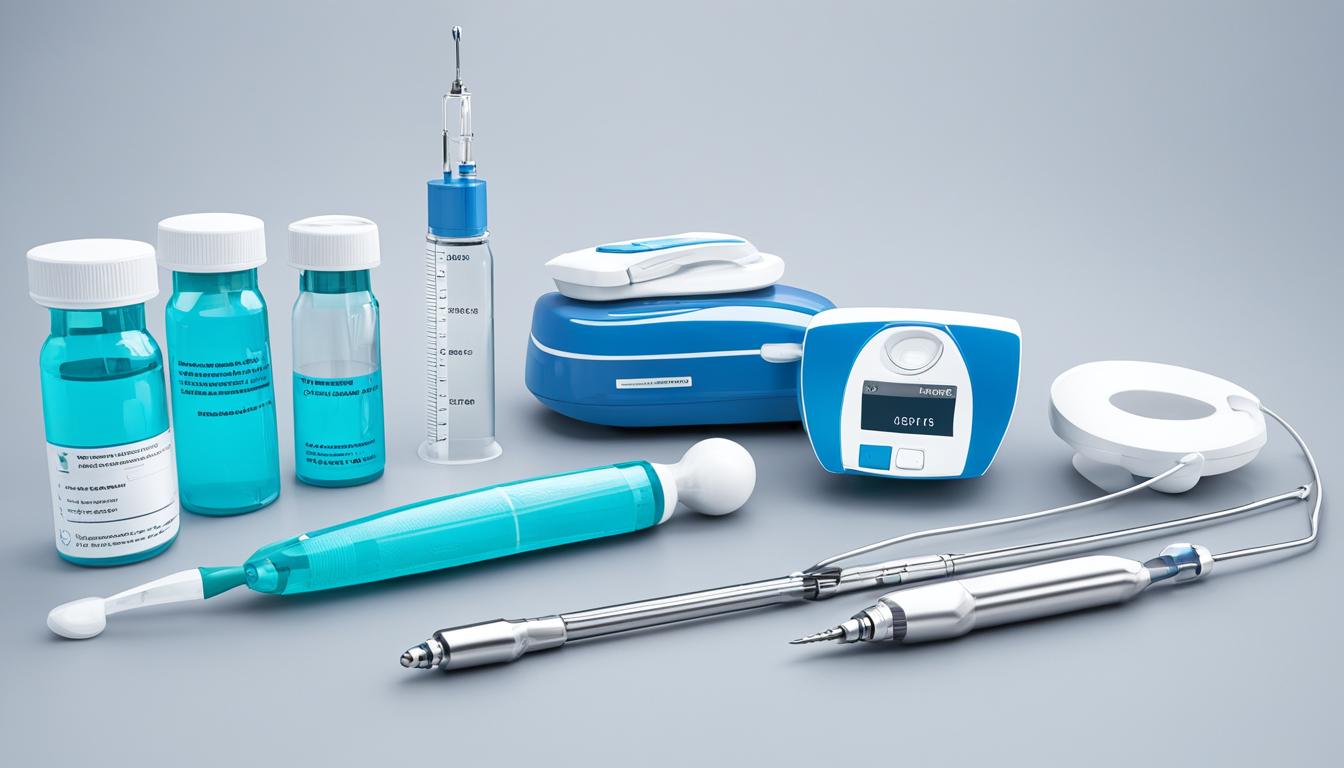Welcome to our comprehensive guide on the best treatment options for men with unfavorable intermediate-risk (UIR) prostate cancer. When it comes to managing prostate cancer, it’s crucial to explore effective and innovative approaches that can provide optimal outcomes for patients. In this article, we will delve into various treatment options available for UIR prostate cancer, including both radiotherapy and surgical interventions. Whether you’re a patient, caregiver, or healthcare professional, our aim is to provide you with valuable insights that can help inform decision-making and improve patient outcomes.
Key Takeaways:
- Unfavorable intermediate-risk (UIR) prostate cancer requires timely and appropriate treatment for optimal outcomes.
- Treatment options for UIR prostate cancer include external-beam radiotherapy (EBRT) plus androgen deprivation therapy (ADT), brachytherapy, and surgical interventions like robotic prostatectomy.
- Studies suggest that combining ADT with radiotherapy, such as EBRT or brachytherapy, improves overall survival in men with UIR prostate cancer.
- Robotic prostatectomy is a minimally invasive surgical option that aims to remove the prostate while preserving nerve function and urinary control.
- It’s important for patients to consult with their healthcare providers to determine the most suitable treatment approach based on individual factors and preferences.
Radiotherapy Options for Unfavorable Intermediate-Risk Prostate Cancer
When it comes to treating unfavorable intermediate-risk (UIR) prostate cancer, there are several radiotherapy options available that have shown promising results. Two main approaches that have gained recognition are external-beam radiotherapy (EBRT) and brachytherapy, often used in combination with androgen deprivation therapy (ADT).
EBRT involves the use of high-energy beams to target and destroy cancer cells in the prostate. This non-invasive treatment approach has proven to be effective in improving the overall survival of men with UIR prostate cancer. By precisely directing radiation to the affected area, EBRT minimizes damage to surrounding healthy tissues.
Brachytherapy, on the other hand, involves the implantation of tiny radioactive seeds directly into the prostate. These seeds release radiation over time, effectively targeting the tumor and sparing healthy tissues. Brachytherapy can be performed as a standalone treatment or in combination with ADT, further enhancing its effectiveness.
Combining EBRT with brachytherapy and ADT has demonstrated positive outcomes in terms of overall survival and treatment success rates in men with UIR prostate cancer. This multimodal approach allows for a comprehensive treatment strategy that targets the cancer from different angles.
“Combining EBRT with brachytherapy and ADT has demonstrated positive outcomes in terms of overall survival and treatment success rates”
It is essential to consult with a healthcare provider to determine the most suitable treatment option based on individual factors such as overall health, age, and personal preferences. The choice between EBRT, brachytherapy, or a combination of both depends on various factors and should be made in consultation with a medical professional.
Risks and Benefits of Radiotherapy Options
Both EBRT and brachytherapy have their risks and benefits when it comes to treating UIR prostate cancer. It is crucial to be aware of these to make informed decisions about the preferred treatment approach.
| Treatment Option | Risks | Benefits |
|---|---|---|
| External-Beam Radiotherapy (EBRT) | – Potential side effects such as fatigue, urinary problems, and erectile dysfunction – Long treatment duration (typically 4-8 weeks) |
– Non-invasive treatment option – Precisely targets the tumor while minimizing damage to healthy tissues |
| Brachytherapy | – Risk of urinary and bowel side effects – Potential sexual dysfunction – Requires a minor surgical procedure for seed implantation |
– Direct delivery of radiation to tumor site – Minimizes damage to surrounding tissues – Shorter treatment duration than EBRT |
Understanding the potential risks and benefits of each radiotherapy option is critical in making an informed decision about the best course of treatment for UIR prostate cancer.
Surgical Options for Unfavorable Intermediate-Risk Prostate Cancer
In the pursuit of effective treatment for unfavorable intermediate-risk (UIR) prostate cancer, surgical options play a crucial role. Among these options, robotic prostatectomy stands out as a minimally invasive procedure that offers significant benefits. By utilizing the da Vinci robot, surgeons can perform precise removal of the prostate gland while preserving nerve function and urinary control. This approach enhances patient outcomes and facilitates a quicker recovery.
Nerve-sparing surgery is another important aspect of surgical treatment for UIR prostate cancer. This technique aims to protect the delicate nerves surrounding the prostate during surgery, ultimately preserving sexual function in patients. Recognizing the impact of this aspect on quality of life, surgeons prioritize nerve preservation whenever feasible.
In some cases, a lymph node dissection may also be performed as part of the surgical treatment plan. This procedure helps determine whether the cancer has spread to the lymph nodes, providing valuable information for further management and treatment decisions.

When considering the surgical options for unfavorable intermediate-risk prostate cancer, it is crucial to consult with a skilled and experienced surgical team to assess individual circumstances and develop a personalized treatment plan.
Radiation Therapy Options for Unfavorable Intermediate-Risk Prostate Cancer
Radiation therapy is a commonly used treatment option for men with unfavorable intermediate-risk (UIR) prostate cancer. It offers effective approaches to target and eliminate cancer cells in the prostate. The following radiation therapy options are available for UIR prostate cancer:
Brachytherapy
Brachytherapy involves the implantation of small radioactive pellets directly into the prostate. The pellets deliver high doses of radiation to the tumor, effectively destroying cancer cells. This treatment option provides precise targeting and minimal impact on surrounding healthy tissue.
External Beam Radiation Therapy (EBRT)
External beam radiation therapy (EBRT) utilizes high-energy beams to target the prostate from outside the body. The radiation beams are carefully directed to destroy cancer cells while minimizing damage to nearby organs and tissues. EBRT is a non-invasive procedure that can be completed over several weeks.
Stereotactic Body Radiotherapy (SBRT)
Stereotactic body radiotherapy (SBRT) is a cutting-edge technique that delivers highly focused radiation to the prostate in a few treatment sessions. This non-invasive approach utilizes advanced imaging and computer-guided technology to precisely target the tumor, minimizing radiation exposure to healthy tissues and reducing treatment time.
“Radiation therapy options such as brachytherapy, external beam radiation therapy, and stereotactic body radiotherapy have proven to be effective in treating unfavorable intermediate-risk prostate cancer.”
Each of these radiation therapy options offers advantages in treating UIR prostate cancer. The choice of treatment will depend on several factors, including the patient’s overall health, preferences, and the expertise of the medical team. It is important to consult with a healthcare provider to determine the most suitable radiation therapy approach for individual cases of UIR prostate cancer.
| Treatment Option | Advantages |
|---|---|
| Brachytherapy | Precise targeting, minimal damage to surrounding tissues |
| External Beam Radiation Therapy (EBRT) | Non-invasive, completed over several weeks |
| Stereotactic Body Radiotherapy (SBRT) | Highly focused, minimal radiation exposure, reduced treatment time |
Conclusion
When it comes to treating unfavorable intermediate-risk (UIR) prostate cancer, there is no one-size-fits-all approach. The optimal treatment strategy depends on multiple factors, including the patient’s preferences, overall health, and the expertise of the medical team. As we have discussed, recent studies have shed light on some effective therapies for UIR prostate cancer.
Radiotherapy options, such as external-beam radiotherapy (EBRT) with or without brachytherapy, combined with androgen deprivation therapy (ADT), have shown promise in improving overall survival rates for men with UIR prostate cancer. These treatments involve delivering precise doses of radiation to the prostate gland, effectively targeting and killing cancer cells. Surgical options, such as robotic prostatectomy and lymph node dissection, can also be considered, providing potential benefits in terms of removing the cancerous prostate and assessing lymph node involvement.
It is crucial for individuals diagnosed with UIR prostate cancer to consult with their healthcare providers. By having open and honest discussions with medical professionals, patients can gain a deeper understanding of the available treatment options and make informed decisions about their care. Together, with personalized medical guidance and access to innovative therapies, we can optimize the management of UIR prostate cancer and improve outcomes for patients.
FAQ
What are the treatment options for unfavorable intermediate-risk prostate cancer?
Men with unfavorable intermediate-risk prostate cancer have several treatment options, including external-beam radiotherapy (EBRT) plus androgen deprivation therapy (ADT) or EBRT plus brachytherapy boost with or without ADT. Brachytherapy alone or in combination with ADT has also shown improved overall survival compared to EBRT alone.
How does external-beam radiotherapy (EBRT) with androgen deprivation therapy (ADT) treat unfavorable intermediate-risk prostate cancer?
EBRT combined with ADT is a recommended treatment option for unfavorable intermediate-risk prostate cancer. It involves delivering high-energy beams to the prostate to kill cancer cells and suppress the production of hormones that fuel prostate cancer growth.
What is brachytherapy and how is it used to treat unfavorable intermediate-risk prostate cancer?
Brachytherapy is an effective treatment option for unfavorable intermediate-risk prostate cancer. It involves the placement of radioactive seeds directly into the prostate to deliver targeted radiation therapy. Brachytherapy can be performed alone or in combination with ADT.
What is robotic prostatectomy and how is it used in the treatment of unfavorable intermediate-risk prostate cancer?
Robotic prostatectomy is a surgical option for unfavorable intermediate-risk prostate cancer. It is a minimally invasive procedure performed using the da Vinci robot, allowing for precise removal of the prostate gland while preserving nerve function and urinary control. Nerve-sparing surgery aims to preserve sexual function by protecting the nerves during the procedure.
What is lymph node dissection, and when is it performed during prostate cancer treatment?
Lymph node dissection is a surgical procedure performed during prostate cancer treatment to determine if the cancer has spread to the lymph nodes. It involves removing and examining the lymph nodes near the prostate to assess the extent of the disease.
What are the radiation therapy options for unfavorable intermediate-risk prostate cancer?
Radiation therapy is a commonly used treatment option for unfavorable intermediate-risk prostate cancer. Brachytherapy involves the implantation of small radioactive pellets into the prostate, delivering high doses of radiation directly to the tumor. External beam radiation therapy (EBRT) uses high-energy beams to target the prostate. Stereotactic body radiotherapy (SBRT) is a non-invasive technique that delivers highly focused radiation over a few treatment sessions.
How do radiation therapy options improve outcomes for unfavorable intermediate-risk prostate cancer?
Radiation therapy options such as brachytherapy, EBRT, and SBRT have shown to effectively treat unfavorable intermediate-risk prostate cancer by delivering targeted radiation to the tumor. These treatments have been associated with improved overall survival rates.
What factors should be considered when determining the best treatment approach for unfavorable intermediate-risk prostate cancer?
The optimal treatment approach for unfavorable intermediate-risk prostate cancer depends on factors such as the patient’s preferences, overall health, and the expertise of the medical team. It is important for patients to consult with their healthcare providers to determine the best treatment approach for their specific case of unfavorable intermediate-risk prostate cancer.
What are some of the latest advancements in the treatment of unfavorable intermediate-risk prostate cancer?
Advances in the treatment of unfavorable intermediate-risk prostate cancer include the use of advanced imaging techniques for more precise targeting of radiation therapy, the development of new surgical techniques to improve outcomes and minimize side effects, and the use of personalized treatment approaches based on the individual characteristics of the patient’s cancer.
What are the Treatment Options for Prostate Cancer and Prostate Stones?
For prostate cancer, treatment options include surgery, radiation, hormone therapy, and chemotherapy. For prostate stones, dissolving solutions or medication may be used to break down the stones and help them pass through the urinary system. Both conditions require careful consideration and consultation with a healthcare professional.



